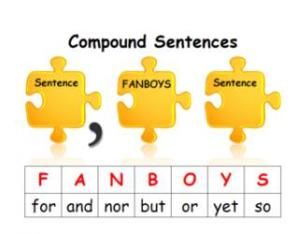概念
兩個或兩個以上的簡單句用並列連詞連在一起構成的句子,叫做並列句,其基本結構是“簡單句+並列連詞+簡單句”。並列連詞有:and,but,or,so等.並列句中的各簡單句意義同等重要,相互之間沒有從屬關係,是平行並列的關係。它們之間用連詞連結。
如:
I like action movies but don't like thrillers.
Hurry up or you'll be late. (快點,否則你要遲到了。)
and,or和but都是連詞,在句中連線兩個或兩個以上的並列成分。可連線兩個詞,兩個短語,兩個分句,但所連線的兩個成分必須一致,絕不能一個是詞,一個是句子。如:
I like red and orange.
He isn't my brother or my friend.
I like playing football and swimming.
and 的意思是“和”,表示前後兩個成分的並列或對稱關係;or的意思是“或者”、“否則”、 “要不然”,表示兩個成分並列或選擇關係;but 的意思是“但是”,表示兩個成分之間的轉折關係。
並列句中:1.表並列關係的 由and,both...and,as well as,not only...but (also),neither...nor等組成。
She not only sings but also dance.
2.錶轉折關係的 與but,however(然而),while(然而),still,yet等連用。
The film is not perfect,still,it's good.
3.表選擇關係的 由or,either...or...,not...but...,or else(否則)連線
Take the chance,or else you will regret(後悔) it.
4.表因果關係的 與for,so/so that,therefore(因此),because等連用。
I'd better take an umbrella,for it is going to rain.
口訣
and 表示順承
while表示對比
but/yet表示轉折
for/so表示因果
or/either ...or 表示選擇
and/then/when表示時間
and/so/neither/nor表示並列
not only...but also/neither... nor表示遞進
分類
由並列連詞把兩個或兩個以上的簡單句連在一起的句子叫並列句。不同的並列連詞表示並列分句之間的不同關係。根據並列分句之間的關係不同,並列句可以分為以下幾種:
表示聯合關係的並列句
這類並列句常用並列連詞and (和),not only ... but also... (不但……而且……)等來連線,這時分句之間是順承關係或並列關係。and一般不譯出來。例如:
1. We bought her a birthday present,_____ she liked it very much. (2005年岳陽市)
A. so B. or C. and D. but
[分析]根據語境,句意為“我們為她買了一件生日禮物,她非常喜歡。”表示聯合關係,故選C。
2. — Didn’t you give roses to your father on Father’s Day?
— Oh,not only my father,_____ my grandpa got red roses. (2005年包頭市)
A. or B. and C. but D. until
[分析]結合語境,表示聯合關係,not only ... but also ...不但……而且……中的also可省略,故選C。
表示轉折關係的並列句
這類並列句常用but (但是;可是),yet(可是;然而),while (而)等來連線,後面分句與前面分句之間有意義上的轉折關係。例如:
1. — Would you like to go to the concert with me?
— I’d love to,_____ I can’t. I have a lot of homework to do. (2005年北京市)
A. or B. but C. so D. and
[分析]語境分析,表示轉折關係,故應選B。
2. The doctors tried their best to save the patient’s life,_____ failed (2005年上海市)
A. or B. so C. but D. because
[分析] 該句意為“醫生們盡力挽救那個病人的生命,但是失敗了。”表示轉折關係,故應選C。
表示選擇關係的並列句
這類並列句常用並列連詞or(或者),either … or … (要么……,要么……)等連線。例如:
1. _____ Lily _____ Lucy may go with you because one of them must stay at home. (2005年吉林省)
A. Not only; but also
B. Neither; nor
C. Both; and
D. Either; or
[分析]根據句意可知,兩人中只有一個人可以去,表示選擇關係,故選D。
2. None of the shoes in the shops are the right size. They are _____ too big _____ too small. (2005年寧波市)
A. both; and B. neither; nor
C. either; or D. not only; but also
[分析]結合語境,“這些商店裡的鞋尺碼都不合適。它們要么太大,要么太小。”表示“要么……要么……”,故選C。
3. “Are you going to eat here ____ take it away?” asked the waiter.. (2005年山東省)
A. and B. so C. or D. but
[分析]結合語境,表示選擇關係,故選C。
表示因果關係的並列句
這類並列句常用並列連詞so(因此;所以),for(因為)等連線,後面分句與前面分句之間有因果關係。例如:
1. Mother was ill,_____ Father cooked for us instead. (2005年新疆)
A. but B. or C. so D. and
[分析]根據語境,“媽媽病了,所以爸爸代替她為我們做飯。”表示結果,故選C。
2. There is a lot of traffic in this city,_____ look both ways before crossing the street (2005年杭州市)
A. so B. and C. but D. for
[分析]該句意為“這座城市車輛很多,所以過馬路前要兩邊看。”表示“所以”。故選A。
特殊的並列句
1. 祈使句+and+一般將來時的句子
這個句型表示“如果做到了祈使句表示的事情,就會有後面句子表示的結果”。例如:
Study hard,_____ you are sure to have a good result in the exam. (2005年天津市)
A. or B. and C. for D. but
[分析]語境分析,“努力學習,你一定能在考試中取得好成績。故選B。
2. 祈使句 + or + 一般將來時的句子
這個句型表示“如果做不到祈使句表示的事情,就會有後面句子表示的結果”。例如:
1. Be quick,_____ we’ll be late for class. (2005年貴州省畢節地區)
A. or B. so C. and D. but
[分析]該句意為“快點,不然的話我們上課要遲到了。”表示“否則;不然”,故選A。
2. Come a little earlier next time,_____ you’ll miss the best part of the TV play. (2005年濟南市)
A. and B. but C. or D. till
[分析]該句意為“下次早點來,不然的話你會錯過這部電視劇最精彩的部分。”表示“否則;不然”,故選C。

